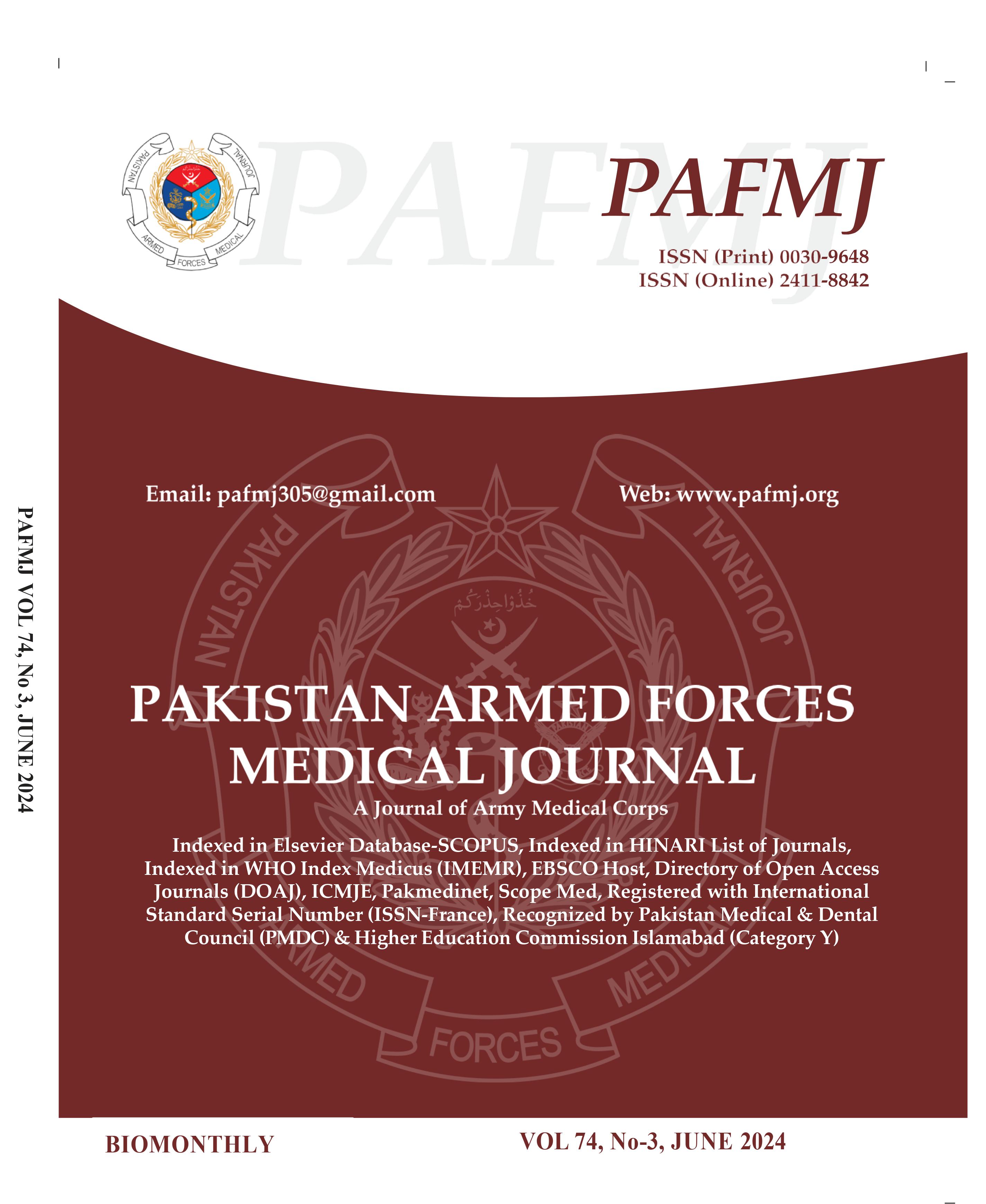Comparison between Primary Repair and Ileostomy in the Management of Typhoid Intestinal Perforation
DOI:
https://doi.org/10.51253/pafmj.v74i3.9405Keywords:
Intestinal perforation, Primary repair, Typhoid feverAbstract
Objective: To compare the outcomes of primary repair with ileostomy in the management of typhoid intestinal perforation.
Study Design: Quasi-Experimental Study.
Place and Duration of Study: Surgical Departments of Combined Military Hospital, and Pak Emirates Military Hospital, Rawalpindi Pakistan, from Nov 2021 to Jun 2022.
Methodology: A total of 400 patients presenting with typhoid ileal perforation were recruited. Patients of either gender, aged under 60 years with a positive blood culture for S. Typhi were included. Those with a history of abdominal surgery or ileal perforation due to any cause other than typhoid were excluded. The study population was categorized into two groups (A, and B) of 200 patients each. Group-A received primary repair, and Group-B received ileostomy. Complications were compared between both groups. A primary outcome (mortality) was also examined.
Results: Mean age of patients noted was 22.47±14.8 years. In Group-A, 124(62%) patients, and in Group-B 118(59%) patients were males. Postoperative wound infection was the most frequent complication found, in 32(16%) patients in Group-A and 44(22%) patients in Group-B. No complications were found in 96(48%) patients in Group-A and
80(40%) patients in Group-B. The mortality rate was higher in Group-B 34(17%) in comparison to Group-A 22(11%).
Conclusions: Primary repair is a safe technique, and it has less morbidity and mortality in comparison to ileostomy for treatment of typhoid intestinal perforation.
Downloads
References
Parry CM, Hien TT, Dougan G, White NJ. Farrar JJ. Typhoid fever. N Engl J Med 2002; 347: 1770-1780.
https://doi.org/10.1056/nejmra020201
Vollaard AM, Ali S, Widjaja S, van Asten HA, Visser LG, Surjadi C, et al. Identification of typhoid fever and paratyphoid fever cases at presentation in outpatient clinics in Jakarta, Indonesia. Trans R Soc Trop Med Hyg 2005; 99(6): 440-450.
https://doi.org/10.1016/j.trstmh.2004.09.012
Das JK, Hasan R, Zafar A, Ahmed I, Ikram A, Nizamuddin S, et al. Trends, associations, and antimicrobial resistance of Salmonella typhi and paratyphi in Pakistan. Am J Trop Med Hyg 2018; 99(3).
https://doi.org/10.4269%2Fajtmh.18-0145
John J, van Aart CJ, Grassly NC. The burden of typhoid and paratyphoid in India: systematic review and meta-analysis. PLoS Negl Trop Dis 2016; 10(4): e0004616.
https://doi.org/10.1371/journal.pntd.0004616
Esa H, Norazlah B, Hameed AA, Ding CH, Wahab AA. Typhoid fever presenting as acute psychosis in a young adult: case report and literature review of typhoid psychosis. Trop Biomed 2021; 38(2): 192-195.
https://doi.org/10.47665/tb.38.2.057
Jeon HJ, Lee JS, Lee BS, Kim SH, Lee ES. Typhoid fever presenting with gastric ulcer bleeding. BMC Gastroenterol 2022; 22(1): 1-5. https://doi.org/10.1186/s12876-022-02192-2
Shane AL, Mody RK, Crump JA, Tarr PI, Steiner TS, Kotloff K, et al. Infectious Diseases Society of America clinical practice guidelines for the diagnosis and management of infectious diarrhea. Clin Infect Dis 2017; 65(12): e45-80.
https://doi.org/10.1093/cid/cix669
Mogasale V, Ramani E, Mogasale VV, Park J. What proportion of Salmonella Typhi cases are detected by blood culture? A systematic literature review. Ann Clin Microbiol Antimicrob 2016; 15(1): 8.
https://doi.org/10.1186/s12941-016-0147-z
Wabada S, Oyinloye AO, Usman B, Abubakar AM, Christopher RU. Typhoid perforation in children below 5 years: a 10-year review of cases managed and outcome. Pediatr Surg Int 2021: 6.
https://doi.org/10.1007/s00383-021- 05010-0
Naby CS. Acute Peritonitis Generalized by Typhoid Perforation at Kankan Regional Hospital. Jpn J Gastroenterol Hepatol 2021; 5(8): 5.
http://doi.org/10.47829/JJGH.2020.5803
Fatima M, Kumar S, Hussain M, Memon NM, Vighio A, Syed MA, et al. Morbidity and Mortality Associated with Typhoid Fever Among Hospitalized Patients in Hyderabad District, Pakistan, 2017-2018: Retrospective Record Review. JMIR Public Health Surveill 2021;7(5):e27268. https://doi.org/10.2196/27268
Ukwenya AY, Ahmed A, Garba ES. Progress in management of typhoid perforation. Ann Afr Med 2011; 10(4).
https://doi.org/10.4103/1596-3519.87040
Jeon HJ, Marks F, Sugimoto J, Im J, Kang SS, Haselbeck A, et al. Surge oftyphoid intestinal perforationsas possible result of COVID-19 associated delays in seeking care, Madagascar. Emerg Infect Dis 2021; 27(12): 3163.
https://doi.org/10.3201/eid2712.210516
Ujan JA, Khokhar Z, Solangi S, Soomro P, Hussain KU, Ghumro S, et al. Screening of Enteric Fever in the Human Population of District Khairpur, Sindh, Pakistan. Pak J Med Health Sci 2022; 16(02): 851-855.
https://doi.org/10.53350/pjmhs22162851
Khan M. A plausible explanation for male dominance in typhoid ileal perforation. Clin Exp Gastroenterol 2012; 5: 213.
https://doi.org/10.2147%2FCEG.S36569
Samsoor Zarak M, Sana H, Shah M, Lehri SA, Saghir M, Gul Q. Association of clinical features of typhoid fever with socioeconomic status in Balochistan, Pakistan. East Mediterr Health J 2021; 27: 1078-1083.
Downloads
Published
Issue
Section
License
Copyright (c) 2024 Utban Ali Shah, S M Ammar Rameez, Khurram Sarfaraz Bajwa, Momina Javed, Tabish Iqbal, Asad Malik

This work is licensed under a Creative Commons Attribution-NonCommercial 4.0 International License.















